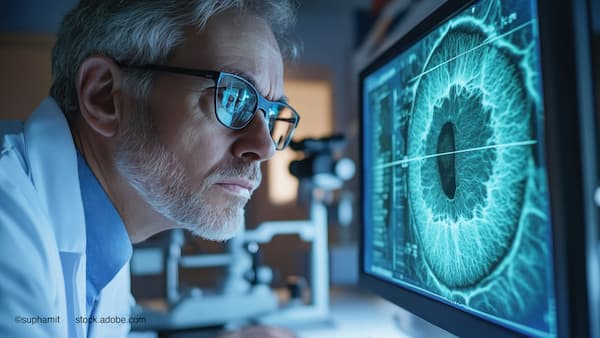Commentary
Article
When the world went virtual: How ophthalmology’s conferences stayed on track
Author(s):
Five years after the COVID-19 pandemic shutdown reshaped how the world gathers, here's how some of ophthalmology’s leading associations are still applying lessons forged in crisis
From pivot to progress: The post-pandemic evolution of ophthalmic medical meetings reflects resilience, innovation, and a renewed appreciation for the power of in-person connection. (Image credit: AdobeStock/Anton Gvozdikov)

As the spring conference season hits its stride, it’s a fitting moment to reflect on how ophthalmic medical meetings have evolved since COVID-19 first upended live events. In the early days of the pandemic, associations like the American Academy of Ophthalmology (AAO), American Society of Cataract and Refractive Surgery (ASCRS), and American Society of Retina Specialists (ASRS) became lifelines for the profession—pivoting fast, staying connected, and delivering education under extraordinary constraints.
Now, with in-person meetings in full force, the Eye Care Network asked these organizations to look back on what changed, what stuck, and how they’re preparing for the next unexpected disruption.
Debra Rosencrance, vice president of meetings and exhibits at the AAO, noted that physicians want two things most in a meeting—education and networking. Education has many components—lectures, focused comprehensive courses, skills acquisition laboratories, and others. Networking goes all the way from structured opportunities to simply seeing your friends in the halls and in the evenings.
“In 2020, we made the decision to offer a virtual only AAO annual meeting option,” Rosencrance said. “In 2021, we began offering both in-person and virtual meeting options, and continue to do so.”
The decision to have an onsite, in-person meeting versus a virtual meeting required a number of preconditions, she continued.
“First and foremost, it had to be safe,” she said. “That meant that COVID-19, in the opinion of public health experts, had to be sufficiently under control. Vaccine requirements were put into place based on these same public health recommendations.
“Second, the meeting venues (hotels and convention center) had to demonstrate the ability to safely screen guests and structure the meeting rooms and foot traffic avenues to permit appropriate social distancing so that people felt safe,” Rosencrance added.
Finally, Rosencrance said they listened to members. Many members wanted an in-person meeting for the networking benefits, while some members expressed interest in a hybrid option for flexibility.
“Like many other medical societies, we were forced to cancel our Annual Meeting, which was originally scheduled for May 2020,” said Steve Speares, ASCRS Executive Director. “We were one of the first medical societies in the country to pivot to a virtual event, and were able to still hold some of the sessions/symposia virtually over the original weekend that we should have been in Boston.”
While it was rewarding to put something together for members, the experience of meeting virtually had an emptiness to it, which became a theme throughout the pandemic, he noted.
“In 2021, we were originally scheduled to hold our annual meeting in April in San Francisco,” Speares said. “Once again, we had to pivot to a new location (Las Vegas) and new time (July) but managed to pull off the first live medical meeting west of the Mississippi. But it was important for us to be able to offer that live in-person event that our members and industry representatives craved. That event more than any other, confirmed the value of human interaction which had been missing during the pandemic.”
In addition to considerations for adapting the Annual Meeting, we also continued to offer valuable education in other formats, namely in virtual webinars, according to Speares. Specifically, the 20/Happy in 2020 program was a great success, which featured the ability for attendees to earn CME credit by learning through 10 virtual learning modules focused on cataract and refractive surgery.
“This masterclass was a great way for ASCRS members to keep up with their education during the pandemic,” he said.
In addition to 20/Happy, several other virtual education opportunities were born out of necessity in the pandemic and still are being produced by the society today, including Quicksand Chronicles, and ASCRS Grand Rounds, Speares added.
Retina is one of the most rapidly evolving spaces in medicine and retina specialists rely heavily on meetings to remain at the forefront of new science, therapeutics, and technology for the betterment of patient care, said Gaurav K. Shah, MD, FASRS, Program Chair for the 43rd ASRS Annual Scientific Meeting scheduled to take place from July 30 - August 2, 2025, at the Long Beach Convention Center in Long Beach, California.
“In 2020, ASRS pivoted quickly and hosted a highly successful virtual Annual Scientific Meeting,” Shah said. “At the time, there was much public speculation about whether in-person meetings were a thing of the past. In retina circles, this notion was quickly dispelled by physicians who voted with their feet returning to our 2021 hybrid meeting in masks and in droves.
“The new hybrid meeting was in fact a quantum leap forward,” Shah continued. “Offering parallel in-person and virtual options expanded the Society’s reach and continues to provide enormous flexibility for attendees. Some attend in person, some virtually and some leverage the livestream to watch potions of the meeting while on site. Hybrid is here to stay.”
From necessity to strategy: Reinventing the medical meeting
Innovations in event formats, including virtual and hybrid models, have left a lasting impact on how medical meetings are designed and delivered today.
Whether it is in person or virtual, attendees love being able to ask questions of key opinion leaders (KOLs), AAO’s Rosencrance said.
“We originally thought that the virtual option would allow attendees to do that in every session so we had a virtual physician moderator for every live session for the first few years of the hybrid model,” she said. “However, for whatever reason, there were not a lot of questions. So we no longer have physician moderators for the live sessions.
“What we did keep was a virtual Ask the Experts where it’s just a live Q & A session with KOLs based on topic,” she added. “It’s only offered to the virtual audience and it remains one of the most popular virtual sessions.”
Through all of this, it’s evident that people really want networking, according to Rosencrance.
“We’ve been working to increase structured opportunities for attendees to meet the KOLs they want to meet,” she said. “A new thing we added last year was ‘Continue the Conversation’ areas just off the symposia stage. The idea is that the speakers go to this area immediately following the session to answer questions from attendees. It was very successful last year.”
Speares noted that ASCRS had success in its virtual offerings.
“While nothing can replace the impact of a live meeting, we did see success in being able to offer a virtual meeting option during the pandemic, and this has helped to expand options and variations in programming still offered today,” he said. Things like webinars, virtual events, and podcasts allow ophthalmologists who are interested to watch on their own time or tune in live, when that option is available.
“I think members continue to appreciate the variety in offerings,” he said.
Members who attend the ASCRS Annual Meeting have historically had the option to access ASCRS On Demand after the meeting. This digital content recorded from the meeting allows them to go back and rewatch something they’re interested in or catch up on a session they missed, which is valuable to the physician who’s really trying to take advantage of everything our meeting has to offer, Speares added.
“The pandemic also impacted our internal operations as ASCRS moved from expensive Class A office space in suburban Washington, DC, to a small government relations office near the capitol and a small administrative office in Fairfax, Virginia,” he said. “This dramatically cut our expenses at a critical time. We also moved our Executive Committee Monthly Meetings to a virtual zoom call and moved one of our two annual retreats to a virtual event, also saving money.”
Built to bend: Planning for the next disruption
Lessons from navigating pandemic-era challenges continue to inform preparations for potential future disruptions to large-scale events.
“The most important lesson we learned is that anything can be accomplished by taking it one step at a time,” AAO’s Rosencrance said. “Our motto for 2020 was ‘Bird by Bird,’ which is a reference to Anne Lamott’s book.
She added that they also learned that a virtual expo really just needs to be a resource center where attendees can find out more about certain products. Attendees are not interested in interacting with virtual exhibitors.
“Maintaining a virtual option provides us the opportunity to flip to virtual only if required for whatever disruption occurs,” she added. “While it’s not ideal, it still provides the opportunity for attendees to hear the latest treatment options that is improving patient care which is the ultimate goal.”
“First and foremost, there is no guarantee ASCRS is always going to exist,” Speares said. “The organization is run on the volunteer spirit and personal time put in by our leadership, and revenue generated by our memberships, meeting attendance, and industry support. Without these critical support pillars there would not be an ASCRS. Having just celebrated our 50th anniversary it really drove home how hard individual surgeons have worked to build a collegial society to further anterior segment surgery.”
There is no substitute for in-person gatherings, he added.
“I think we learned that we can still provide excellent education for our members in a variety of formats,” Speares said.
Being together in person is irreplaceable—it facilitates important discussions, builds relationships and enables interactions that do not happen organically in a virtual environment— but physicians can still gain some important education and skills in virtual and hybrid environments, and this opens options for providing education year-round, he said.
“We’ve expanded our offerings, both in-person and virtual, in order to offer the variety of content and education that interests and meets our members’ needs,” Speares added. “We continue to seek innovative ways to bring members what they’re looking for to be successful in their practices.”
Shah noted the importance of flexibility in planning for medical education delivery.
“We’ve learned that in today’s world, there are any number of scenarios that could necessitate a quick temporary return to an all-virtual format,” he said. “ASRS is prepared with a playbook of strategies and procedures learned during COVID that will allow the Society to adapt and continue to meet the educational needs of the retina community.
“People need people,” Shah said. “We are driven by science but defined by our shared experiences. Retina physicians continue to place a high premium on being in-person to experience all that a meeting has to offer in terms of education, investigation of new technologies and most importantly collaboration with colleagues. Case in point, abstract submissions for ASRS 2025, July 30-August 2 in Long Beach, California, have reached record levels again this year.”
Attendees can look forward to a rich array of experiences and activities including a focus on investigator-led studies on innovative surgical-oriented techniques, instrumentation, and outcomes. ASRS will host a Retina Surgical Summit and Battle of the Continents debate, as well as a hand-on Experience Center, according to Shah.
Newsletter
Don’t miss out—get Ophthalmology Times updates on the latest clinical advancements and expert interviews, straight to your inbox.




